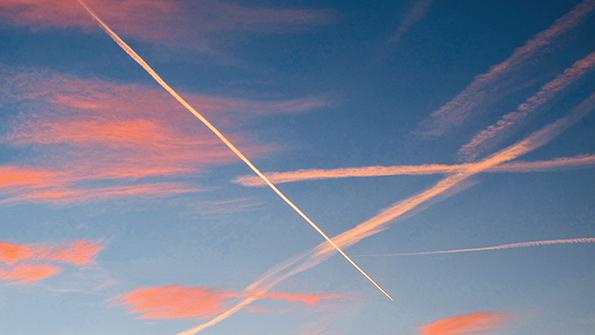
In a bid to find an effective and immediate way to curb aviation’s contribution to global warming, one of the busiest air traffic control centers in Europe is conducting live tests of vertical flight profile-based action to avoid the formation of contrails.
Condensation trails, or contrails, are still the subject of research to gain better insight into their formation and their impact on climate change. The latter two phenomena have yet to be described with any scientifically satisfactory precision, but the big picture is already clear. Contrails play a major role in aviation’s radiative forcing effect, which quantifies the difference between the solar energy absorbed by the Earth and the energy radiated back into space.
The move by Eurocontrol’s Maastricht Upper-Area Control Center (MUAC) marks a shift toward real-world evaluation of green measures that may help commercial air transport progress swiftly. As opposed to gradual technological and industrial advances in more environmentally friendly engines and fuels, a change in air traffic management (ATM) may apply to the entire sector overnight. Moreover, the sought-after improvements may be obtained by requesting flight level changes from a few flights in the area.
When water vapor is ejected from the exhaust nozzle of an aircraft engine into sufficiently cold air, it condenses and freezes, creating tiny ice crystals. In certain atmospheric conditions, these ice crystals create layers of wispy cirrus clouds.
Such clouds negatively affect the Earth’s net radiative equilibrium. Although they reflect incoming sunlight back into space, at night they cause a “blanket” effect, keeping warmer air trapped in the lower atmosphere. The second impact prevails, studies show.
By avoiding so-called ice-supersaturated regions (ISSR) in the atmosphere, aircraft can reduce the likelihood of forming persistent contrails.
Aviation accounts for 3.5% of anthropic radiative forcing, according to climate scientists. Non-CO2 effects, including contrails, represent two-thirds of that contribution.
MUAC manages the upper airspace—from 24,500 ft. to 66,000 ft.—over Belgium, the Netherlands, Luxembourg and northwest Germany. In 2019, before the COVID-19 crisis, the organization routed an average of 5,100 flights per day.
This year, from Jan. 18 through Dec. 31, MUAC is experimenting with operational measures. A small flight level change—for example, diverting an aircraft 2,000 ft. up or down from its normal flight path—may be enough to thwart contrail formation.
For validation purposes, Eurocontrol has partnered with German aerospace research agency DLR to perform satellite image analyses. DLR assesses the vertical distribution of contrails and compares it with a prediction model, using flight data and weather forecasts.
“Optimized air traffic management will keep deviations from the requested flight level to a minimum and strive for environmentally optimized flight profiles,” Eurocontrol says. “There will be no horizontal rerouting as part of the trial, and flights in their climb or descent phase within MUAC airspace will in general not be affected.” As part of the trials, MUAC may request any flight to “tactically deviate” from the planned flight level between 3 p.m. and 5 a.m., Central Europe Time in the summer and an equivalent period in the winter.
The team is looking for an optimal balance between the reduction in contrail formation and the additional CO2 emissions that may result from the altitude change.
MUAC estimates that only a small proportion of flights will be affected by contrail-prevention clearances. A study of Japan’s airspace found that most of the contrail warming was caused by just 2% of the flights.
MUAC’s controllers and engineers note that they have used the traffic downturn as an opportunity to fine-tune their systems and procedures. They have already found that ISSR prediction must be improved; real-time detection of ISSRs is critical. In addition to current-generation satellites, tools such as ground-based cameras, lidars and unspecified next-generation satellites might help.
Depending on the results of the ongoing experiment, Eurocontrol will plan a demonstration in a larger region beyond the MUAC area.
A deeper comprehension of aviation’s non-CO2 climate effects is also essential. “Studies are recent, and cautiousness is therefore required,” says Marc Dufresnoy, deputy head of the aircraft environmental performance office at DGAC, France’s civil aviation authority.
Contrails generally last only a few minutes; however, depending on their environment, they can morph into linear cirrus clouds that endure for several hours. Those clouds sometimes transform into long-lasting, not necessarily linear cirrus.
Various gases contribute to such cloud transformations. Nitrogen oxides (NOx), though not greenhouse gases (GHG) per se, have cascading effects with various durations. Ozone, a GHG, can form from NOx. In a second phase, NOx can destroy methane, a GHG as well. And the reduction in methane concentration causes water vapor (another GHG) to decrease in concentration, too. At a later stage, less methane means less ozone.
Whereas CO2's effects endure for hundreds of years because that gas remains in the atmosphere, the effects of other GHGs have shorter durations. The phenomena that start with methane destruction can last a combined 10 years.
Scientific uncertainties are still significant for non-CO2 effects, Dufresnoy notes. The formula for calculating methane’s radiative forcing was recently updated and now includes the representation of shortwave radiation effects.


Comments
https://www.sciencedirect.com/science/article/pii/S2590198219300338?CMX_ID=ECR-140176&SIS_ID=140176&dgcid=STMJ_75273_AUTH_SERV_PPUB&utm_acid=25204107&utm_campaign=STMJ_75273_AUTH_SERV_PPUB&utm_dgroup=Email1Publishing&utm_in=DM597592&utm_medium=email&utm_source=AC_30